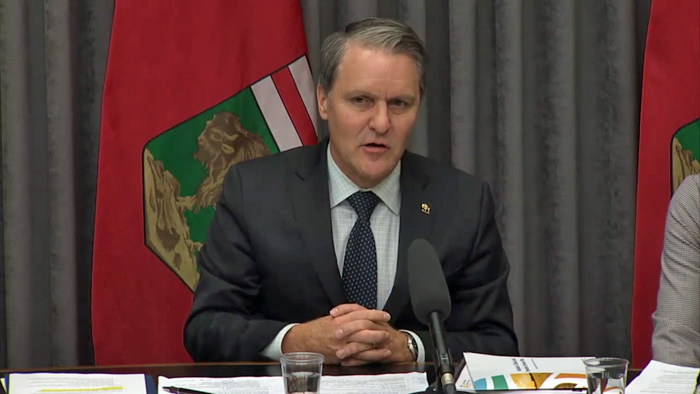Manitoba will move forward with a comprehensive plan to enhance the availability, quality and reliability of care for patients at home and in the community, including rural and northern residents.
Manitoba’s Clinical and Preventive Services Plan was developed by nearly 300 clinical leaders over the past 18 months and included the input of thousands of front-line providers. It provides a roadmap for changes that will decrease travel and wait times for patients, bringing improved health-care capacity closer to home.
“Our government has committed to investing $2 billion in Manitoba’s health-care system over the next four years including $250 million for initiatives identified by clinical leaders that will improve access to services and reduce wait lists for Manitoba patients,” said Health, Seniors and Active Living Minister Cameron Friesen. “This made-in-Manitoba plan provides a blueprint to improve how we plan and where we deliver services, allowing us to better meet the needs of rural and northern residents while reducing their need to travel to Winnipeg.”
The plan outlines the historical challenges of delivering care to rural and remote populations and offers recommendations to enhance primary and community care across Manitoba including improved access to digital health solutions, diagnostics, emergency response and patient transportation. New investments that support the plan’s recommendations will reduce the need for patients to travel to Winnipeg for services, which will also free up capacity at the city’s acute-care hospitals.
“This plan will guide our efforts to improve local access to health services and meet the needs of communities in areas like prevention, screening and management of chronic diseases,” said Lanette Siragusa, provincial lead, health system integration and quality, and chief nursing officer, Shared Health. “It will support our efforts to build up some sites to care for sicker patients closer to home, enhancing local capabilities and connecting providers with specialty teams.”
Over the next five years, the plan is expected to:
- move 21,000 days of care away from Winnipeg’s acute facilities and back into local communities across the province;
- prevent the need for 2,500 patient transports to Winnipeg, as rural facilities are better equipped to provide care;
- give all Manitobans access to lab results via a new secure patient service portal, eliminating the need to travel to doctors and specialists to retrieve those results;
- provide 50,000 additional in-person home care visits while modernizing the system to provide more and better care;
- provide 800 Manitobans with access to remote monitoring of their chronic conditions, allowing them to remain in the community, closer to home; and
- extend Manitoba’s acute care electronic record system to 800,000 patients, enabling health-care providers to have a clear and consistent understanding of their patients’ care requirements.
Led by Shared Health, Manitoba’s Clinical and Preventive Services Plan marks the first time that health-care providers and system leaders from across the province have come together to identify gaps, propose solutions and establish a common plan for a more co-ordinated, integrated and effective provincial health system.
“The next generation of Manitoba physicians is already being trained to work as part of multi-disciplinary teams that co-ordinate the care provided to patients across the province. Our model of health-care education is providing opportunities for students to train in rural facilities where we hope they will choose to remain,” said Dr. Don Klassen, medical director, Manitoba Health Care Provider Network with Shared Health, and a rural family physician who participated as a member of the plan’s Integrated Leadership Team. “The plan includes welcome steps that will make it easier for rural physicians to access specialist support and expertise, and increase their ability to manage more complex patients safely at rural facilities and in the community.”
The government has authorized Shared Health to begin detailed implementation planning including continued engagement of local clinical providers, operational leaders and communities. This process will be supported by clinical leaders in Shared Health and leaders from across the health system.
“In some places, including Manitoba’s north, we are already using collaborative approaches to care, with providers working in teams to support the needs of patients, often using digital tools to increase access to specialized services without the need for patients to travel for care,” said Brenda Dawyduk, nurse practitioner, Thompson General Hospital, and co-lead, Child Health Provincial Clinical Team. “Increasing our ability to provide care closer to home will mean working in new and different ways with interdisciplinary teams supporting care locally and specialized support teams accessible both virtually and in-person when required.”
In the months ahead, detailed investments that improve the standards of care will be determined and announced, as will further discussion on community practices identified by experts as not meeting clinical standards, the minister said. He added that clinical experts and community leaders will be involved in these discussions.
Over the next five years, clinical experts will regularly assess the population need and system capabilities of all services and sites within the network model. This will include close monitoring of population growth in southern Manitoba, the availability of long-term care, and necessary investments in digital health, diagnostics, patient transport and staffing.
“This plan calls for us to build up the services available to Manitobans in their local communities, making sure they are safe and reliable, and that Manitobans know where to go and have timely access to the care they need,” said Friesen. “This is about working together across the province to build a provincial health system.”





